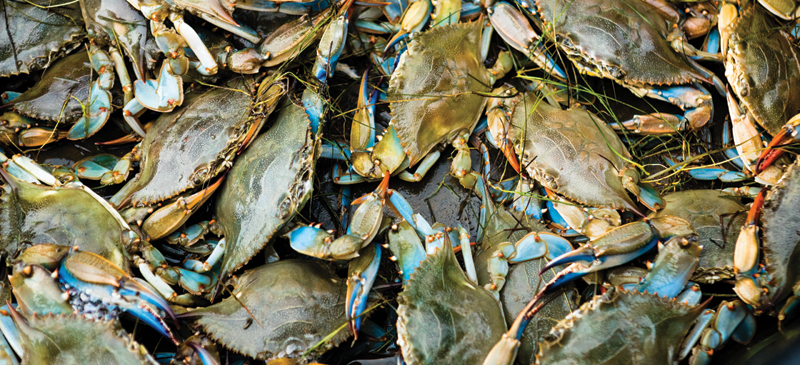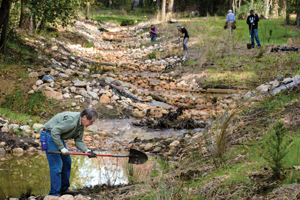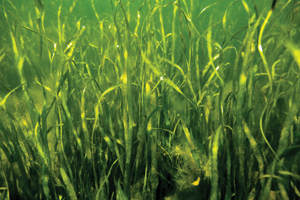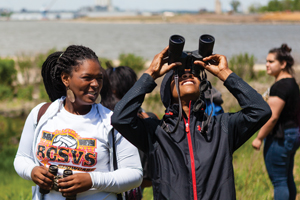Our Shared Role: Resilience abounds throughout the watershed

Blue crabs are harvested near the Honga River in Somerset County. The crab pots used to catch them were set by educators as part of the Teachers on the Estuary Workshop led by staff from the Maryland Department of Natural Resources, National Oceanic and Atomospheric Administration, and the Chesapeake Bay Foundation. (Photo by Will Parson/Chesapeake Bay Program)
Progress. It’s a word with many definitions, including, “A forward or onward movement toward an objective or goal.”
At the Chesapeake Bay Program, progress is measured in the 10 goals of our Chesapeake Bay Watershed Agreement. When our partnership—consisting of Delaware, the District of Columbia, Maryland, New York, Pennsylvania, Virginia, West Virginia, the Chesapeake Bay Commission and the Environmental Protection Agency—signed the agreement in 2014, it did so with a vision toward an environmentally and economically sustainable region. We envisioned abundant life, clean water, conserved lands, water access and the engagement of a diverse array of citizens and stakeholders, and we set goals in order to make that vision a reality.

Volunteer Rich Kuhlman participates in a planting at a stream restored by South River Federation in Annapolis. The restoration includes 1,500 feet in the headwaters of Church Creek, a tributary of the South River in Anne Arundel County, and is the last of multiple projects targeting Church Creek that will benefit the Chesapeake Bay. (Photo by Will Parson/Chesapeake Bay Program)
Four years have now passed since the signing, and for many of the outcomes, the target date of 2025 grows nearer every day. The Chesapeake Bay Program’s annual snapshot of our progress, the 2016-2017 Bay Barometer, provides us reasons for optimism and shows the power of the actions we’ve already taken.
Measuring resiliency
Signs of resiliency—many that hadn’t been seen in years—are now being noted throughout the region. These positive trends allow us to be cautiously optimistic about bay restoration. The key word here is cautiously. Even though there is much to celebrate, threats to this fragile ecosystem still exist, particularly in the forms of disease, overharvesting, pollution from agriculture, stormwater and urban runoff, and growth.
But it is thanks to the efforts of the individuals throughout the watershed—including the many local citizens, communities, governments and nonprofit organizations—that promising signs can be seen. These people are on the ground every day, taking steps to thwart the threats that face the bay.
Maryland’s commitment to the Chesapeake Bay Program’s efforts has led to some recent notable achievements for the state, as well as the entire watershed. The state’s iconic blue crab abundance is at record levels. In 2017, 254 million female blue crabs were counted, surpassing our target of 215 million.

A healthy patch of wild celery and other bay grasses grow in the Susquehanna Flats near Havre de Grace. (Photo by Will Parson/Chesapeake Bay Program)
Thriving habitat
One reason for this increase is the thriving population of underwater grasses. Underwater grass beds are a crucial element to the ecosystem. They keep our waters clean by absorbing excess nutrients, trapping suspended sediment, and slowing wave action and shoreline erosion. They also offer food to small invertebrates and migratory waterfowl, while at the same time providing shelter to blue crabs and young fish.
Underwater grasses are sensitive to pollution but quick to respond to water quality improvements, so their abundance is an excellent indicator of bay health. In 2016, 97,668 acres of underwater grasses were mapped throughout the bay—the highest amount ever recorded by the annual aerial survey conducted by the Maryland Department of Natural Resources and the Virginia Institute of Marine Science. This record-breaking figure achieved 53 percent of our goal to achieve and sustain 130,000 acres by 2025.
Fish and oyster populations are seeing progress as well. Maryland recently named two additional sites for oyster restoration—Breton Bay and the Upper St. Mary’s River—helping to meet our goal to restore native habitat in 10 bay tributaries by 2025. In 2016, 1,126 miles of streams were opened for fish passage, including 22 miles in Maryland, which helps herring, shad and other migratory fish reach their spawning grounds. This exceeded our goal to restore 1,000 miles of historical fish migration routes.
Increased access
Fish aren’t the only creatures traversing local waterways with more ease. As of 2016, there are now 601 sites throughout Maryland where the public can access the water for boating, fishing, kayaking or swimming.
As part of the Watershed Agreement, Chesapeake Bay Program partners are committed to opening 300 new sites by 2025. Thanks to these efforts, 44 percent of this goal has now been achieved.
Focus on education
At some of these sites, students attending schools in the Maryland Green Schools Program are taking actions to reduce the impact of their buildings and grounds on their local watersheds. They also are protecting the environment and human health through best practices, including student-led protection and restoration projects.
With 401 of Maryland’s schools certified as sustainable, they make up 82 percent of the current total of 12 percent of public and charter schools in the Chesapeake Bay watershed.

DeShawn Wheeler, right, spots birds through binoculars while on a nature walk with fellow Benjamin Franklin High School students at Masonville Cove in Baltimore. (Photo by Will Parson/Chesapeake Bay Program)
Sustainable schools—along with citizen stewardship, diversity and environmental literacy—are some of the newest indicators of progress that are tracked in the Watershed Agreement. Our partners are committed to increasing the capacity and diversity of engaged residents, because individuals have the power to improve the environment, as proven in the Bay Program’s first-ever Citizen Stewardship Index. In research conducted in early 2017, we found that 73 percent of Marylanders want to do more to help protect their local rivers and streams.
As Governor Larry Hogan said, “The Chesapeake Bay is our greatest natural asset, and our administration has been working tirelessly for three years to restore it and protect our environment. The growing engagement of individuals around the watershed, as well as the sustained commitment of our many partners only ensures that we’ll continue to see progress. Together we have made great strides, and we are committed to continuing to make historic investments and fight for the bay. It will take all of the bay jurisdictions and our federal partners working together to build on this incredible progress and secure the Chesapeake for future generations.”
Article by Rachel Felver—Chesapeake Bay Program communications director. Appears in Vol. 21, No. 2 of the Maryland Natural Resource magazine, spring 2018.


 1-888-373-7888
1-888-373-7888 233733
233733